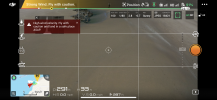Droning on and on...
Well-Known Member
Thanks for keeping us in the loop, Rip!
Sorry for the length...
Many (most?) of us would consider that the "point of failure".
What?!??
All 100% wrong. I've proven this empirically, comparing actual behavior and performance to the "Wind Resistance" specification for the Mini3P.
Summary: We don't know what DJI means by "Max Wind Resistance". From actual operation, behavior, and performance, however, we can infer with some confidence that it at least means the max wind speed the drone can fly directly into and still make decent forward progress, able to return to the Home Point (battery charge permitting). Read on for the details.
===================================================
We have no idea how DJI measures or computes "Wind Resistance". What I can say with certainty is it is not the max wind speed that can hold a hover, in which case no forward flight directly into the wind is possible.
The Mini3P, and presumably all DJI drones can fly faster through the air at max tilt than their specified max ground speed, which is what the Flight Controller targets – ground speed. We do not have a Pitot Tube or other means to sense airspeed... The FC has only ground speed values derived from GPS and the VPS system.
At max tilt, based on flight log data, It looks like the Mini3P has a max airspeed around 40mph. This leaves a 5mph margin to fly directly into the wind in Sport mode and still achieve max ground speed at 35mph.
Flying directly into an estimated 10mph wind in Sport the Mini3P topped out at ~30mph.
With this real data, the 3P could theoretically hold position in a 40mph wind. By DJI Forum Jaboney's theory, "Max Wind Resistance" would therefore be about 18m/s.
The spec, however, says 10.7m/s. At that wind speed, the Mini3P has an additional 7m/s or about 15mph "headroom" against the wind to make it back.
IOW, testing shows that "Max Wind Resistance" could mean max headwind that allows for 15mph progress over the ground.
There's no guesswork here. These are all measured values in real flight on a moderately windy day. The only caveat is these are all estimated values based on using Beaufort Scale observations to estimate wind speed. All other values carry the precision of Flight Log values.
Sorry for the length...
DJI Forum Jaboney said:For DJI drones, the max wind resistance isn't the point of failure, but the limit at which the drone will not be able to tilt into the wind and fight it to remain in place.
Many (most?) of us would consider that the "point of failure".
DJI Forum Jaboney said:What DJI does implement, which is clever, is that the drone will drift with the wind if it exceeds the max wind speed. Not ideal, but also better than the drone tilting over and falling from the sky.
What?!??
DJI Forum Jaboney said:So the max wind speed DJI quotes is really the 'SWL' point in which the drone will give up and just move with the wind. Obviously if you're in a hurricane it's not going to sustain flight, but there is a margin of error and protections in place.
All 100% wrong. I've proven this empirically, comparing actual behavior and performance to the "Wind Resistance" specification for the Mini3P.
Summary: We don't know what DJI means by "Max Wind Resistance". From actual operation, behavior, and performance, however, we can infer with some confidence that it at least means the max wind speed the drone can fly directly into and still make decent forward progress, able to return to the Home Point (battery charge permitting). Read on for the details.
===================================================
We have no idea how DJI measures or computes "Wind Resistance". What I can say with certainty is it is not the max wind speed that can hold a hover, in which case no forward flight directly into the wind is possible.
The Mini3P, and presumably all DJI drones can fly faster through the air at max tilt than their specified max ground speed, which is what the Flight Controller targets – ground speed. We do not have a Pitot Tube or other means to sense airspeed... The FC has only ground speed values derived from GPS and the VPS system.
At max tilt, based on flight log data, It looks like the Mini3P has a max airspeed around 40mph. This leaves a 5mph margin to fly directly into the wind in Sport mode and still achieve max ground speed at 35mph.
Flying directly into an estimated 10mph wind in Sport the Mini3P topped out at ~30mph.
With this real data, the 3P could theoretically hold position in a 40mph wind. By DJI Forum Jaboney's theory, "Max Wind Resistance" would therefore be about 18m/s.
The spec, however, says 10.7m/s. At that wind speed, the Mini3P has an additional 7m/s or about 15mph "headroom" against the wind to make it back.
IOW, testing shows that "Max Wind Resistance" could mean max headwind that allows for 15mph progress over the ground.
There's no guesswork here. These are all measured values in real flight on a moderately windy day. The only caveat is these are all estimated values based on using Beaufort Scale observations to estimate wind speed. All other values carry the precision of Flight Log values.












